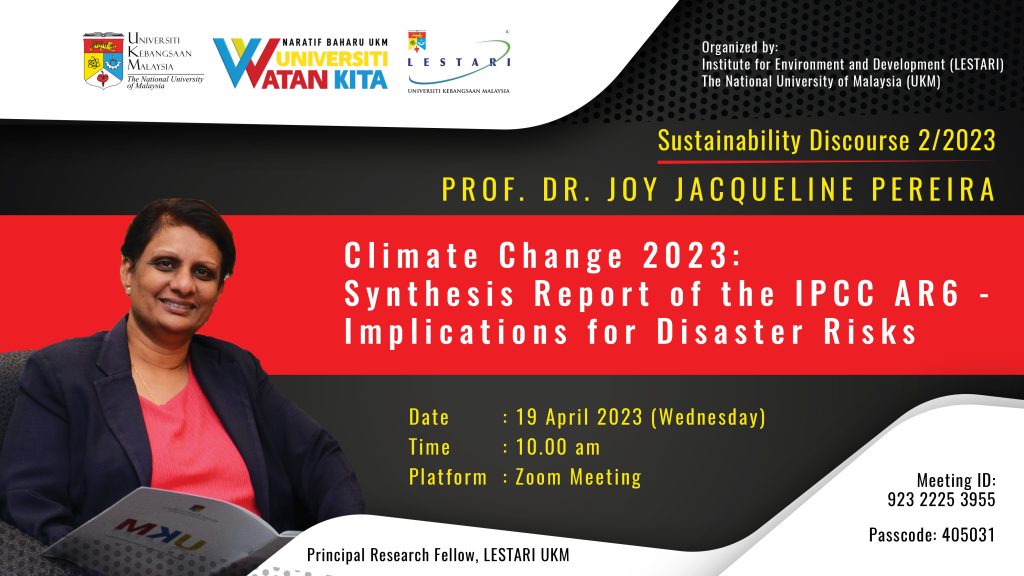Climate Change 2023: The IPCC AR6 Synthesis Report on Implications for Disaster Risks

The Intergovernmental Panel on Climate Change IPCC was a joint recipient of the Nobel Peace Prize in 2007. The role of IPCC has been to assess on a comprehensive, objective, open and transparent basis the scientific, technical, and socio-economic information relevant to understanding the scientific basis of risk of human-induced climate change, its potential impacts and options for adaptation and mitigation.
IPCC reports are neutral with respect to policy, although they may need to deal objectively with scientific, technical, and socioeconomic factors relevant to the application of particular policies. The current synthesis report (AR6) will provide input for the Global Stock Take under the upcoming Paris Agreement. The assessments have been conducted to achieve sustainable development and its goals.
IPCC is an intergovernmental panel with 195 member states with appointed National Focal Points. Hundreds of scientists and experts from around the world are involved in the preparation of IPCC reports. Malaysian researchers could get involved with IPCC by contributing to existing literature because our IPCC assessment area is as good as the literature available. Professor Dr. Joy Jacqueline Pereira, a Principal Research Fellow at Universiti Kebangsaan Malaysia’s Southeast Asia Disaster Prevention Research Initiative (SEADPRI-UKM) and Vice-Chair of the (IPCC), informs that there will be a special report in the next cycle that is dedicated to cities focusing on the science, social and hazard perspectives. Malaysians are encouraged to contribute to the topic so that tropical issues are adequately highlighted in this coming global report.
The AR6 synthesis report is a report that draws on the nine reports that were released in the sixth assessment cycle. The report highlighted adverse impacts from human-caused climate change that will continue to intensify if no actions are taken. The impacts are widespread and cover water availability, food production, health and wellbeing, city settlements and infrastructure due to floods and storms as well as biodiversity and ecosystem. With every increment of global warming, regional changes in mean climate and extremes become more widespread and pronounced. According to the data obtained in the report, annual hottest day temperature, annual soil moisture and annual wettest-day precipitation changes are regionally differentiated. It appears that impacts are more focused along the equatorial belt where Southeast Asia is located. The increased rainfall projected for the region would increase risks related to floods and landslides.
Limiting warming to 1.5°C and 2°C involves rapid, deep, and in most cases, immediate greenhouse gas emission reductions. The reduction must happen in the next decade and cover all sectors including transport, industry, building, energy supply, land-use change, and forestry. There are multiple opportunities for scaling up climate action. In the AR6, climate responses and adaptation options and mitigation options are shown together with respect to the different sectors such as energy supply, land, water, food, settlements, infrastructure, health, society, livelihood, and economy. This sets the scene for climate resilient development and provides policymakers with some concrete examples. Near-term adaptation and mitigation actions have more synergies than trade-offs with Sustainable Development Goals (SDGs). Higher mitigation investment flows are required for all sectors and regions to limit global warming. Southeast Asia requires increased investment flows in mitigation by about 6-9 times. There is a rapidly narrowing window of opportunity to enable climate resilient development. For more details, please download the report from the IPCC website [https://www.ipcc.ch/].
Prevention of disasters is always more cost-effective than responding and recovering from a disaster event. In Malaysia, the National Disaster Management Agency (NADMA) is most experienced in coordinating complex disasters. Most hazards in Malaysia are climate related. It is important to note that disaster prevention is distinct from disaster mitigation. Prevention covers non-structural measures such as legislation, landuse regulations, standards, guidelines and insurance. Aspects of prevention include delineation of disaster-prone areas and vulnerable populations, early warning tools, risk communication and engaging stakeholders. Disaster prevention can be linked well to the National Adaptation Plan by the Ministry of Natural Resources, Environment and Climate Change (NRECC) that is looking at the long-term hazards due to climate change.
Disaster mitigation (which is different from climate change mitigation) encompasses structural measures for reducing disaster risks. It covers both engineering and nature-based structures, drawing on technological and innovative solutions. Ministries and technical agencies need to bridge the silos for integrated implementation risk reduction measures in the country. A solution pathway advocated by the Academy of Sciences Malaysia is to draw on the wealth of knowledge and experience of all operational, research and academic institutions, to harness science to accelerate transformation through a context specific, area-based approach, and promote processes for implementing climate change mitigation, adaptation and disaster risk reduction together. Funded by the Newton-Ungku Omar Fund, SEADPRI-UKM led a Malaysia-UK consortium to develop a Multi-hazard Forecasting System for Kuala Lumpur, as the first step to handle aspects of extreme events at the city-level. This will be expanded to cover mitigation actions to enhance adaptation co-benefits and reduce risk to future climate change in the city.
Written by : Puteri Amirah Nabilah Azman, Nurfashareena Muhamad & Joy Jacqueline Pereira
SEADPRI-Universiti Kebangsaan Malaysia
This article was published in Buletin SEADPRI, Vol. 26, June 2023, ISSN 2180-1142.

